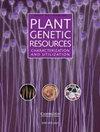辣椒高产F1杂种的配合力、杂种优势和杂种优势选择
IF 0.7
4区 生物学
Q3 PLANT SCIENCES
Plant Genetic Resources: Characterization and Utilization
Pub Date : 2023-06-27
DOI:10.1017/s1479262123000229
引用次数: 0
摘要
从分离代中选育株系和选育杂交种,利用杂种优势或杂种优势是改善辣椒属重要经济性状的有效手段。本研究的目的是在哈瓦那辣椒改良计划中,利用Line × Tester (8 × 2)配种设计,筛选高潜力亲本,获得高产F1杂交品种。对10个亲本和16个杂交种进行了一般配合力、特异配合力、杂种优势和杂种优势评价。亲本NKA-11对果实各定量变量的GCA值最高,适合今后的改良工作,亲本RNJ-04对果实长度的GCA值最高。定量变量的评估证实了所研究的哈瓦那辣椒基因型之间存在显著的遗传变异。最佳杂交品种为NEK-03xRNJ-04、NBA-06xRNJ-04、AKN-07xRNJ-04和RKI-10xRNJ-04,具有较高的生产潜力,产量在3.13 ~ 4.92 Kg/Pta之间,具有开拓全国生鲜消费市场的潜力。结合亲本的GCA值和后代的杂种优势,认为杂交是提高单株产量和结实数的最合适的遗传改良方法。本文章由计算机程序翻译,如有差异,请以英文原文为准。
Combining ability, heterosis, and heterobeltiosis to select highly productive F1 hybrids of habanero pepper (Capsicum chinense Jacq.)
Selection of lines from segregating generations and breeding hybrids to exploit heterosis or heterobeltiosis is an effective tool for improving economically important traits in the genus Capsicum. The objective of this study was to identify high potential parents to obtain high-yielding F1 hybrids using a Line × Tester (8 × 2) mating design in the Habanero pepper improvement programme. Ten parents and 16 hybrids were evaluated in order to determine their values of general combining ability, specific combining ability, heterosis, and heterobeltiosis. Parent NKA-11 had the highest values of GCA for different quantitative variables of the fruit, which does it suitable for future improvement works, and tester RNJ-04 showed the highest value of GCA for fruit length. The quantitative variables evaluated confirm a significant genetic variability among the Habanero pepper genotypes studied. The best hybrids were NEK-03xRNJ-04, NBA-06xRNJ-04, AKN-07xRNJ-04, and RKI-10xRNJ-04, which showed their high productive potential with values between 3.13 and 4.92 Kg/Pta, a quality, that would open to them the national market for fresh consumption. Based on the GCA values of the parents and heterosis of the progenies, it is concluded hybridization would be the most appropriate genetic improvement method to increase both yield (YP) and the number of fruits for plant.
求助全文
通过发布文献求助,成功后即可免费获取论文全文。
去求助
来源期刊

Plant Genetic Resources: Characterization and Utilization
Agricultural and Biological Sciences-Agronomy and Crop Science
CiteScore
2.80
自引率
0.00%
发文量
29
审稿时长
>12 weeks
期刊介绍:
Plant Genetic Resources is an international journal which provides a forum for describing the application of novel genomic technologies, as well as their integration with established techniques, towards the understanding of the genetic variation captured in both in situ and ex situ collections of crop and non-crop plants; and for the airing of wider issues relevant to plant germplasm conservation and utilisation. We particularly welcome multi-disciplinary approaches that incorporate both a technical and a socio-economic focus. Technical aspects can cover developments in technologies of potential or demonstrated relevance to the analysis of variation and diversity at the phenotypic and genotypic levels.
 求助内容:
求助内容: 应助结果提醒方式:
应助结果提醒方式:


